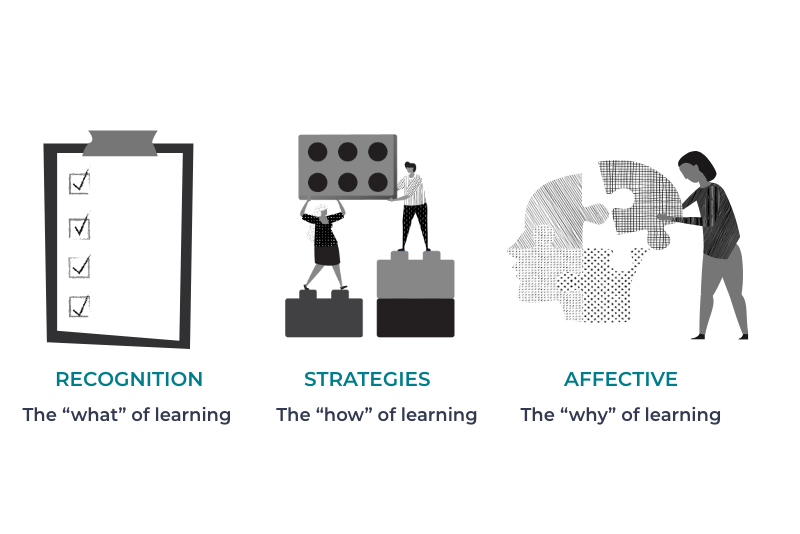Universal Design for Learning (UDL) is a teaching framework for designing your instruction and give all students equal opportunities of success. Every classroom is full of diverse students with their own unique learning styles. You might have a student who speaks two languages, a student who loves to draw, and a student who needs to have their text read out loud all in the same classroom.
Students bring their own needs, strengths, and weaknesses to the class, and it’s important that when we design our curriculum we consider that uniqueness. Universal Design for Learning (UDL) uses a proactive approach to curriculum design to consider the natural variability of how students learn. The end result is a curriculum that’s inclusive for all learning types.
The three types of learning under Universal Design for Learning
Learning isn’t a singular thing. In fact, we know from science that there are three broad learning networks:
- Recognition, or the what of learning.
- Strategies, or the how of learning.
- Affective, or the why of learning.

In order for your students to gain knowledge, strategies, and enthusiasm for learning, you need to create lessons that target all three. Teachers often focus on one or two types of learning, heavily weighting their lessons with engagement strategies. Instead, equal attention needs to be placed on recognition and affect.
A good way to keep the three types of learning under Universal Design for Learning (UDL) in mind is to ensure that all of your lessons have high-quality learning intentions and success criteria.
Design matters
When we use the word design in Universal Design for Learning, we don’t just mean how the curriculum looks but also how it’s used by others.
A well-designed curriculum acts much like a well-designed building. In a universally designed building, architects plan for all types of people, with or without disabilities, who use their building. This means they’ll create ramps for those in wheelchairs, signs with braille for those visually impaired, and maps for their visitors. By designing our curriculum for those in the margins, we create a curriculum that benefits everyone.
When crafting your curriculum it’s important to consider multiple learning types. While this means considering your special education population, it also means designing lessons for stimulating, resourceful, and strategic types of learners.
How does Universal Design for Learning Work?
Designing a curriculum that’s universal can be tricky. After all, no two students are exactly alike, and in a diverse classroom, the task of creating an accessible curriculum can feel daunting. Here are a few steps for how to use the UDL framework to make goals, methods, materials, and assessments that are truly universal.
Step One: Ask yourself, “What is my goal?”
This might seem pretty basic, but it’s the foundation for a strong curriculum under Universal Design for Learning. What do you want your students to know by the end of the lesson, do during the lesson, or care about during and after the lesson?
For example, when creating a lesson plan on the Louisiana Purchase, you might want your students to know what the purchase was, who it was purchased from, and how it was discovered or charted. During the lesson, you might want them to watch a short documentary about Lewis and Clark and sketch a map of the Louisiana Purchase territory. Finally, you might want them to describe the importance of the purchase as it’s related to other expansions in America.
Step Two: Identify the barriers
The next step in your process is to identify the barriers your students might face while learning about the Louisiana Purchase.
You might have students who struggle to understand the vocabulary in the documentary. Some of your students might find the process of map-making beneficial to their learning, while others might find the task challenging or boring. The important point is to consider all possibilities when you’re identifying barriers.
Step Three: Use the 3 Principles of UDL
The three UDL principles are: representation, action and expression, and engagement. These address the three broad areas of learning we all have. By using these three principles you can better ensure that your lessons are accessible to all your students.
1. Representation
Your students are going to learn in different ways. Some might have trouble seeing or hearing your lessons, while others might have cultural differences that make learning your lesson challenging. You might have a classroom full of those who process information quicker using visual or auditory media types. Or, you might have a classroom where students prefer to absorb knowledge through reading.
Since there’s no one way that’s optimal for all of your learners, provide your content in multiple media formats. A documentary might be great for some, but unhelpful for others. Providing the same documentary as written text, illustrative text, or an audio presentation will make sure that every student has the same chance to learn.
2. Action and Expression
Each of your students will have a different way of expressing what they know. Some will struggle with organization, some might have language barriers, and others might have movement impairments. You might have students who express themselves when writing, but not as well speaking.
Give your students multiple ways to show you what they know. While some students might excel at map-making, others do better writing an essay or discussing the concept in small groups. Make sure to provide models, feedback, and supports for their different levels of proficiency.
3. Engagement
Any teacher knows that engagement and motivation are huge factors to student success. They also know that some students are easily motivated, while others are more challenging. Universal Design for Learning asks you to vary your types of engagement to meet the needs of your students.
What excites one student isn’t going to excite another. When designing your lessons, consider how your students might engage with your content and give them options. While some students might love a lecture, others might enjoy reading or creating a project. Both of these types of learning should be accounted for when designing your lessons.
Ultimately, Universal Design for Learning is about finding inclusive solutions to designing a curriculum. By questioning the how, what, and why of your students’ learning, you’ll design better lessons that help all students succeed.
Great resources for learning about Universal Design for Learning
- CAST.org – CAST is a nonprofit education research and development organization that created the Universal Design for Learning Framework and UDL Guidelines.
- The UDL Guidelines – A complete breakdown of the guidelines to Universal Design for Learning. Viewable and searchable online.
- Download your own UDL Guidelines – Download your own copy of the UDL Guidelines to use in your school or while designing your own lessons.
The Progress in the General Curriculum Team provides professional development and technical assistance that is applicable to grades kindergarten through twelve to school districts, schools, and charter schools. Their goal is to provide support for people who are involved in the education of students with disabilities to ensure these students are involved in and show progress in the general curriculum through curricular and instructional adaptations in the least restrictive environment.





Add comment